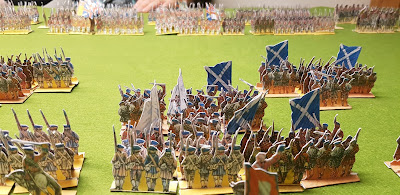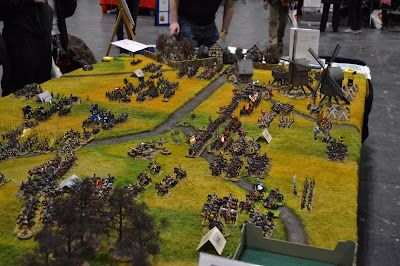Last month I finally fielded my paper Jacobite armies in a refight of the battle of Falkirk (all the gory details can be found here). On that occasion we used Black Powder, a set of rules I'm very familiar with and which I think are pretty good for all periods.
In the post and the subsequent comments my opponent, Anthony, and I had mentioned that the rules that come with the Peter Dennis book seemed a bit daunting. This prompted a comment by Andy Callan, author of the rules, that his rules were a lot more streamlined than Black Powder so, taking that as a bit of a challenge, we decided to re-fight the game using Andy's rules.
As Andy pointed out in his comments,his rules stretch to 5 whole pages with another page devoted to design philosophy... would these be detailed enough to give a challenging game?
The rules include a deployment system which we didn't use as we were playing one of the scenarios in the book but this looks quite interesting. It uses playing cards to initially deploy regiments: players then try to redeploy into period appropriate formations but once one side has met it's 'deployment conditions' the game starts, even if the other side isn't quite ready.
In the main rules units fire first and then move (if they haven't fired) which makes for some interesting decisions about when to unleash that initial volley from the redcoats. The fire and combat values vary for each side meaning the Government troops are very powerful in firing but, as expected, the Highlanders are very effective when charging. An interesting rule for the Highlanders is that when a regiment of, for example, 6 stands advances it gradually shrinks in frontage which reflects the troops bunching up into a mass as they move forward. It means the Highlanders will attack with a narrower frontage unless they decide to halt and redress their lines (which seems like a bad idea when faced with angry redcoats with muskets!).
Movement is suitably limited...troops in this period weren't the most mobile... and if troops are Raw or become Shaken then they can do even less. Highlanders and cavalry are fast but move a variable distance.
Morale is pretty decisive. We found that once a unit began to lose stands then they would quite easily rout. As they pull back this forces other units to test and it can become very infectious as I found to my cost! Due to the brevity of the rules we made a couple of assumptions;
- that each lost stand added to the morale minuses (not just the ones lost in the active turn)
- that hits over the target to remove a stand didn't carry over...not sure about this but it made record keeping easier
We very quickly found that these were a really interesting set of rules...as each turn progressed we'd find another facet of the rules which made us go, 'hmm...that makes sense'. They certainly captured the feeling of warfare in this particular setting and they'd be equally suitable for other settings such as the French Indian Wars with very little tweaking.
So how did the battle go? Let's just say I demonstrated very ably that I can lose a battle regardless of which rules we were using! My line of Highlanders advanced at different speeds which meant they attacked piecemeal and once one unit routed on my right flank, the whole flank decided to join them. That might be my only criticism of the rules...morale failures seem very infectious and it appeared very easy for units to scatter, although maybe that's just my loser's sour grapes! :)
 |
| The Jacobites advance |
 |
| Cavalry clash on the right flank |
 |
| Bonnie Prince Charlie gives a last minute pep talk to his men, but too late to stop them all running away! |

























































